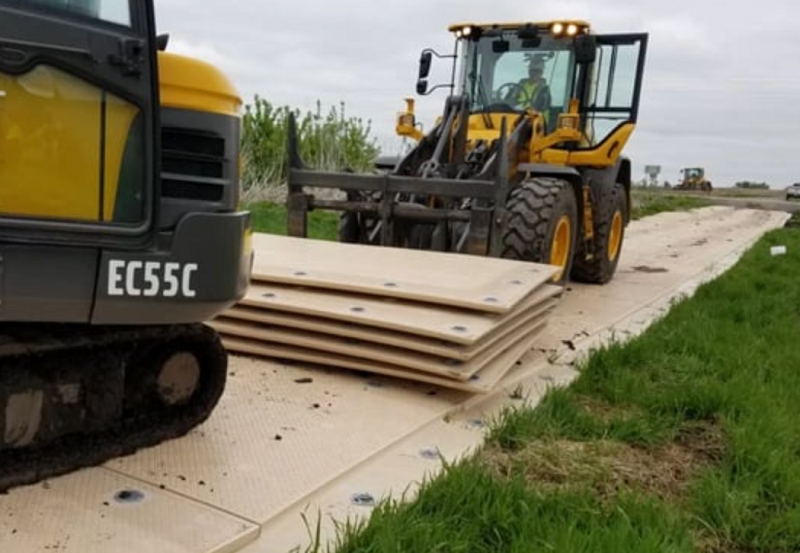Heavy equipment plays a central role in modern construction, but its weight can put stress on soil and site conditions. Without proper ground support, projects risk delays, damage, and increased costs. One effective solution comes from durable mat systems designed to stabilize work areas.
Load Distribution and Ground Protection
The most common use of construction mats is to distribute heavy loads across a wider surface area. By spreading weight evenly, these systems prevent soil from compacting or collapsing under the force of machinery. This reduces rutting, surface damage, and costly repairs to job sites. For areas with soft or uneven ground, mats become critical to safe operation.
Ground protection solutions also reduce environmental impact. Sensitive landscapes, wetlands, or agricultural zones benefit when mats serve as a shield between equipment and soil. This layer minimizes disruption to natural vegetation while ensuring that work can proceed. Protecting both the site and machinery adds long-term value to any project.
Stability for Heavy Equipment
Large cranes, excavators, and transport vehicles depend on a stable base for efficiency and safety. Worksite mats create that stable platform, ensuring machinery does not sink or tilt during operation. Without this support, uneven terrain increases the risk of accidents and equipment damage. The reinforced surface allows operators to maintain productivity without hesitation.
Safety and performance are interconnected when dealing with heavy machinery. With platforms in place, equipment remains steady even on muddy or unstable ground. This steadiness reduces downtime and enhances control for operators. Stability ultimately safeguards both people and assets on the job site.
Case for Safety-First Operations
Construction firms must manage risk on every project. Ground stabilization mats help reduce liability by lowering the chance of accidents linked to unstable ground. They also provide predictable conditions that improve decision-making during critical lifts. Safety gains translate into fewer delays and stronger project outcomes.
Site Access and Mobility
Job sites often present obstacles that complicate access for machinery and vehicles. Temporary roadways allow trucks and equipment to move across soft ground with minimal resistance. This ensures that materials reach their destination on time. Projects in remote or off-road areas especially benefit from this solution.
By reducing the chance of vehicles becoming stuck, mat systems save time and fuel. They also cut down on the need for tow services or additional grading work. Smooth mobility across challenging terrain keeps projects on schedule.
Environmental Considerations
Protecting the environment is an increasing priority for construction projects. Stabilization platforms minimize damage to wetlands, grasslands, and agricultural fields by acting as a barrier between soil and heavy loads. This allows work to proceed while preserving natural ecosystems. Reducing soil compaction ensures land remains fertile and usable after the project ends.
Mats also reduce the risk of runoff and erosion. By stabilizing the ground, they prevent equipment from creating deep ruts that channel water flow. This improves compliance with environmental regulations and community expectations. Protecting natural resources aligns with both legal requirements and responsible project management.
Cost Efficiency and Long-Term Savings
While mats require upfront investment, they deliver savings across multiple project stages. Preventing ground damage reduces the expense of site restoration once work is complete. Equipment also benefits from reduced wear and tear when operating on level, stable surfaces. In many cases, mat systems extend the life of both vehicles and sites.
Reduced downtime offers another financial advantage. Projects that avoid delays caused by stuck machinery or unsafe conditions maintain profitability. Firms that use stabilization platforms consistently also benefit from stronger reputations, winning contracts that demand reliable risk management.
- Lower site restoration costs
- Fewer delays due to unstable ground
- Reduced equipment repairs and downtime
- Stronger reputation for reliable project delivery
These savings compound across multiple projects, reinforcing mats as an investment rather than an expense.
Versatility Across Industries
Although common in construction, ground support systems prove useful across other industries that rely on heavy machinery. Utility companies use them to stabilize the ground during power line or pipeline installation. Oil and gas projects employ mats to protect sensitive drilling sites. Even events requiring temporary roads or staging areas can benefit from the same technology.
Versatility comes from the range of materials and designs available. Hardwood, composite, and steel-reinforced mats each serve different needs. Choosing the right type ensures optimal performance in various conditions. Cross-industry applications highlight the adaptability of mat systems.
Maintenance and Lifespan of Mats
Durable construction mats are designed for repeated use, but proper care maximizes their lifespan. Cleaning after each project prevents the buildup of mud and debris that may reduce traction. Storing mats in dry, covered areas helps preserve their structure. With consistent care, mats remain effective across many years of service.
From distributing loads to providing access across challenging terrain, they enhance operations and reduce risks for firms that depend on heavy equipment. Ground protection mats also deliver cost savings and protect valuable assets. By integrating mat systems into project planning, companies secure both site stability and reliable performance.







